Feedback
Efficiently evaluating LLM applications requires robust tooling to collect and analyze feedback. W&B Weave provides an integrated feedback system, allowing users to provide call feedback directly through the UI or programmatically via the SDK. Various feedback types are supported, including emoji reactions, textual comments, and structured data, enabling teams to:
- Build evaluation datasets for performance monitoring.
- Identify and resolve LLM content issues effectively.
- Gather examples for advanced tasks like fine-tuning.
This guide covers how to use Weave’s feedback functionality in both the UI and SDK, query and manage feedback, and use human annotations for detailed evaluations.
Provide feedback in the UI
In the Weave UI, you can add and view feedback from the call details page or using the icons.
From the call details page
- In the sidebar, navigate to Traces.
- Find the row for the call that you want to add feedback to.
- Open the call details page.
- Select the Feedback column for the call.
- Add, view, or delete feedback:
- Add and view feedback using the icons located in the upper right corner of the call details feedback view.
- View and delete feedback from the call details feedback table. Delete feedback by clicking the trashcan icon in the rightmost column of the appropriate feedback row.
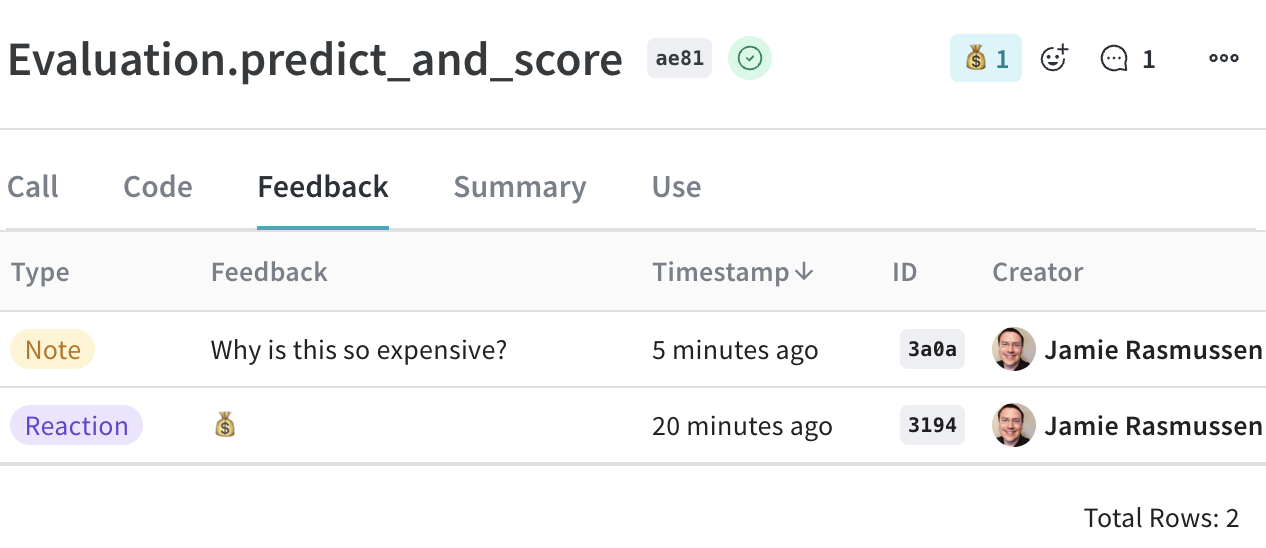
Use the icons
You can add or remove a reaction, and add a note using the icons that are located in both the call table and individual call details pages.
- Call table: Located in Feedback column in the appropriate row in the call table.
- Call details page: Located in the upper right corner of each call details page.
To add a reaction:
- Click the emoji icon.
- Add a thumbs up, thumbs down, or click the + icon for more emojis.
To remove a reaction:
- Hover over the emoji reaction you want to remove.
- Click the reaction to remove it.
You can also delete feedback from the Feedback column on the call details page..
To add a comment:
- Click the comment bubble icon.
- In the text box, add your note.
- To save the note, press the Enter key. You can add additional notes.
The maximum number of characters in a feedback note is 1024. If a note exceeds this limit, it will not be created.
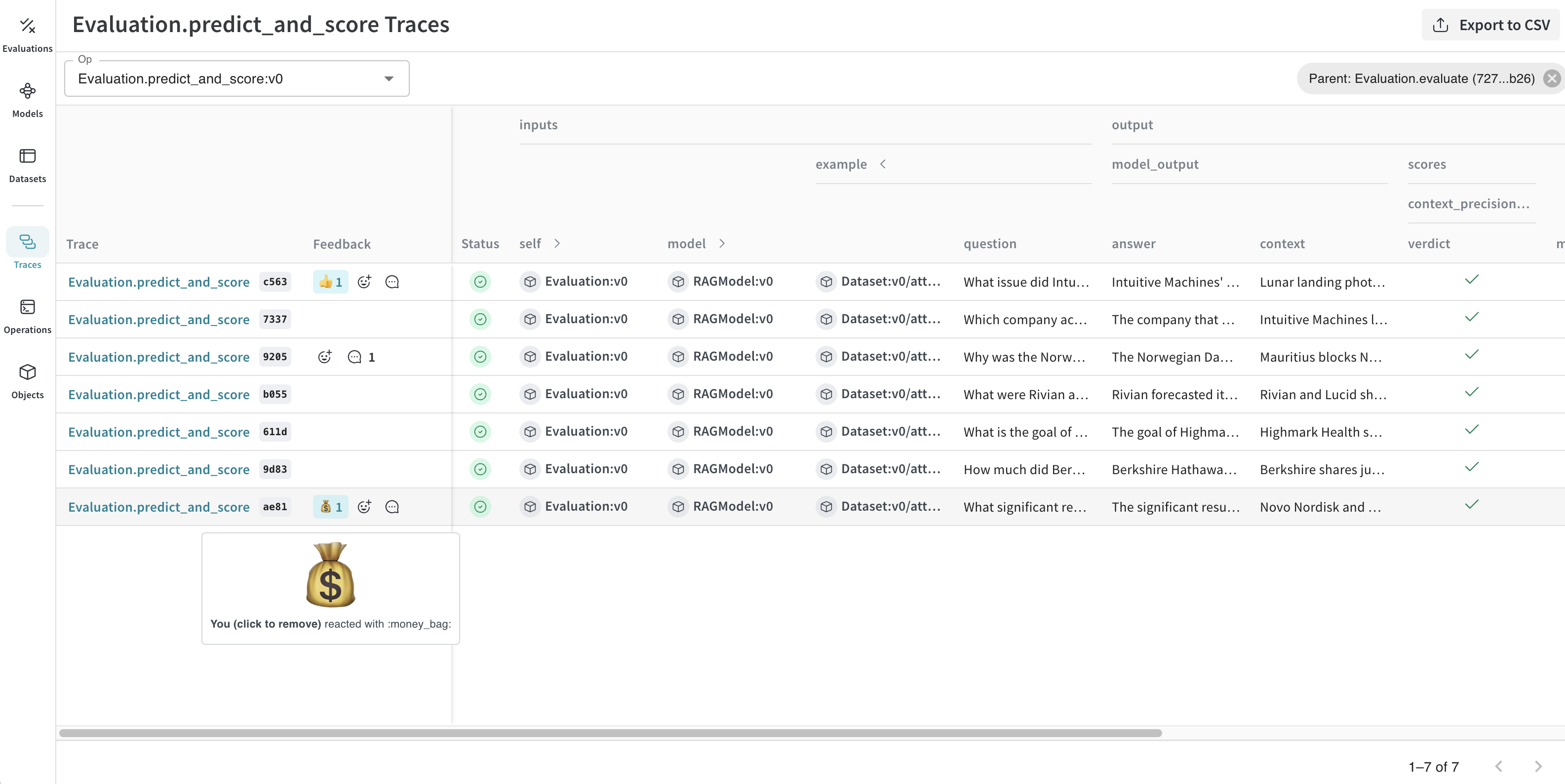
Provide feedback via the SDK
You can find SDK usage examples for feedback in the UI under the Use tab in the call details page.
You can use the Weave SDK to programmatically add, remove, and query feedback on calls.
Query a project's feedback
You can query the feedback for your Weave project using the SDK. The SDK supports the following feedback query operations:
client.get_feedback(): Returns all feedback in a project.client.get_feedback("<feedback_uuid>"): Return a specific feedback object specified by<feedback_uuid>as a collection.client.get_feedback(reaction="<reaction_type>"): Returns all feedback objects for a specific reaction type.
You can also get additional information for each feedback object in client.get_feedback():
id: The feedback object ID.created_at: The creation time information for the feedback object.feedback_type: The type of feedback (reaction, note, custom).payload: The feedback payload
- Python
- TypeScript
import weave
client = weave.init('intro-example')
# Get all feedback in a project
all_feedback = client.get_feedback()
# Fetch a specific feedback object by id.
# The API returns a collection, which is expected to contain at most one item.
one_feedback = client.get_feedback("<feedback_uuid>")[0]
# Find all feedback objects with a specific reaction. You can specify offset and limit.
thumbs_up = client.get_feedback(reaction="👍", limit=10)
# After retrieval, view the details of individual feedback objects.
for f in client.get_feedback():
print(f.id)
print(f.created_at)
print(f.feedback_type)
print(f.payload)
This feature is not available in TypeScript yet. Stay tuned!
Add feedback to a call
You can add feedback to a call using the call's UUID. To use the UUID to get a particular call, retrieve it during or after call execution. The SDK supports the following operations for adding feedback to a call:
call.feedback.add_reaction("<reaction_type>"): Add one of the supported<reaction_types>(emojis), such as 👍.call.feedback.add_note("<note>"): Add a note.call.feedback.add("<label>", <object>): Add a custom feedback<object>specified by<label>.
The maximum number of characters in a feedback note is 1024. If a note exceeds this limit, it will not be created.
- Python
- TypeScript
import weave
client = weave.init('intro-example')
call = client.get_call("<call_uuid>")
# Adding an emoji reaction
call.feedback.add_reaction("👍")
# Adding a note
call.feedback.add_note("this is a note")
# Adding custom key/value pairs.
# The first argument is a user-defined "type" string.
# Feedback must be JSON serializable and less than 1 KB when serialized.
call.feedback.add("correctness", { "value": 5 })
This feature is not available in TypeScript yet. Stay tuned!
Retrieve the call UUID
For scenarios where you need to add feedback immediately after a call, you can retrieve the call UUID programmatically during or after the call execution.
During call execution
To retrieve the UUID during call execution, get the current call, and return the ID.
- Python
- TypeScript
import weave
weave.init("uuid")
@weave.op()
def simple_operation(input_value):
# Perform some simple operation
output = f"Processed {input_value}"
# Get the current call ID
current_call = weave.require_current_call()
call_id = current_call.id
return output, call_id
This feature is not available in TypeScript yet. Stay tuned!
After call execution
Alternatively, you can use call() method to execute the operation and retrieve the ID after call execution:
- Python
- TypeScript
import weave
weave.init("uuid")
@weave.op()
def simple_operation(input_value):
return f"Processed {input_value}"
# Execute the operation and retrieve the result and call ID
result, call = simple_operation.call("example input")
call_id = call.id
This feature is not available in TypeScript yet. Stay tuned!
Delete feedback from a call
You can delete feedback from a particular call by specifying a UUID.
- Python
- TypeScript
call.feedback.purge("<feedback_uuid>")
This feature is not available in TypeScript yet. Stay tuned!
Add human annotations
Human annotations allow you to log feedback about traces from human users. Logging human feedback can help you more accurately assess the behavior of your LLMs, such as ensuring that their responses are accurate and helpful.
To make human annotations, you must first create a human annotation scorer using either the UI or the API. Then, you can use the scorer in the UI to make annotations, and modify your annotation scorers using the API.
Create a human annotation scorer in the UI
To create a human annotation scorer in the UI:
-
From the sidebar, click Assets and then click Scorers from the list of assets.
-
In the upper-right corner, click +New scorer.
-
In the configuration page, set the following fields:
Scorer type: Defines whether to use a human or programmatic annotation. Set to Human annotation.Name: Define a unique name for the scorer.Description: Use this field to instruct users on how to use the scorer, such as, "Was agent's response helpful?"Type: Define the type of feedback the scorer collects. You can choose the following types of feedback:Boolean: CollectsTrueandFalsevalues.Integer: Collects whole number values. Optionally, you can set a range of minimum and maxmimum values for users to select from.Number: Collects number values, including floats. Optionally, you can set a range of minimum and maxmimum values for users to select from.String: Collects user feedback as a string.Select: Allows you to create an arbitrary list of responses for the user to select from, such asGood,Bad, andOkay.
-
Click Create scorer. Now, you can use your scorer to make annotations.
In the following example, a human annotator is asked to select which type of document the LLM ingested. As such, the Type selected for the score configuration is an enum containing the possible document types.
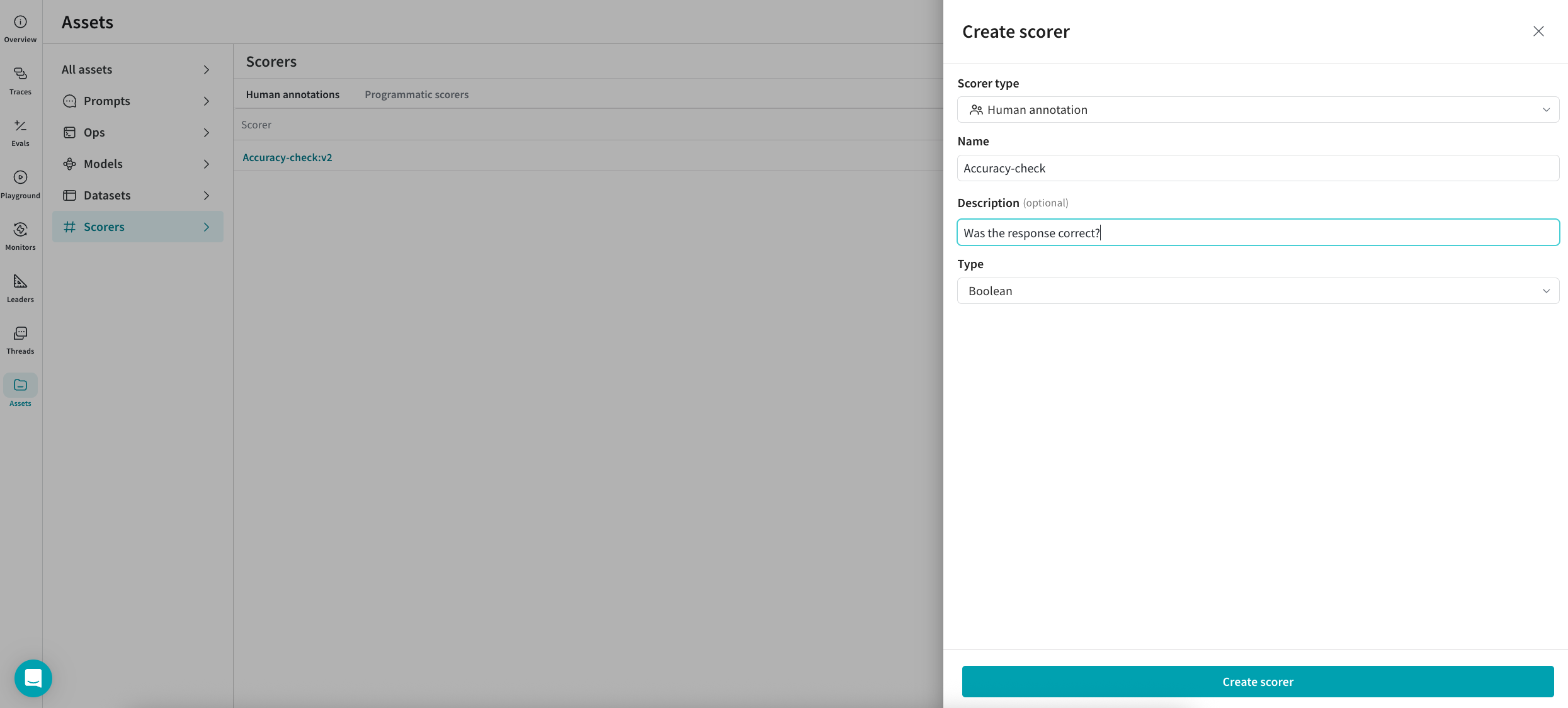
Use the human annotation scorer in the UI
Once you create a human annotation scorer, it will automatically display in the Feedback sidebar of the call details page with the configured options. To use the scorer, do the following:
-
In the sidebar, navigate to Traces
-
Find the row for the call that you want to add a human annotation to.
-
Open the call details page.
-
In the upper right corner, click the Show feedback button.
Your available human annotation scorers display in the sidebar.
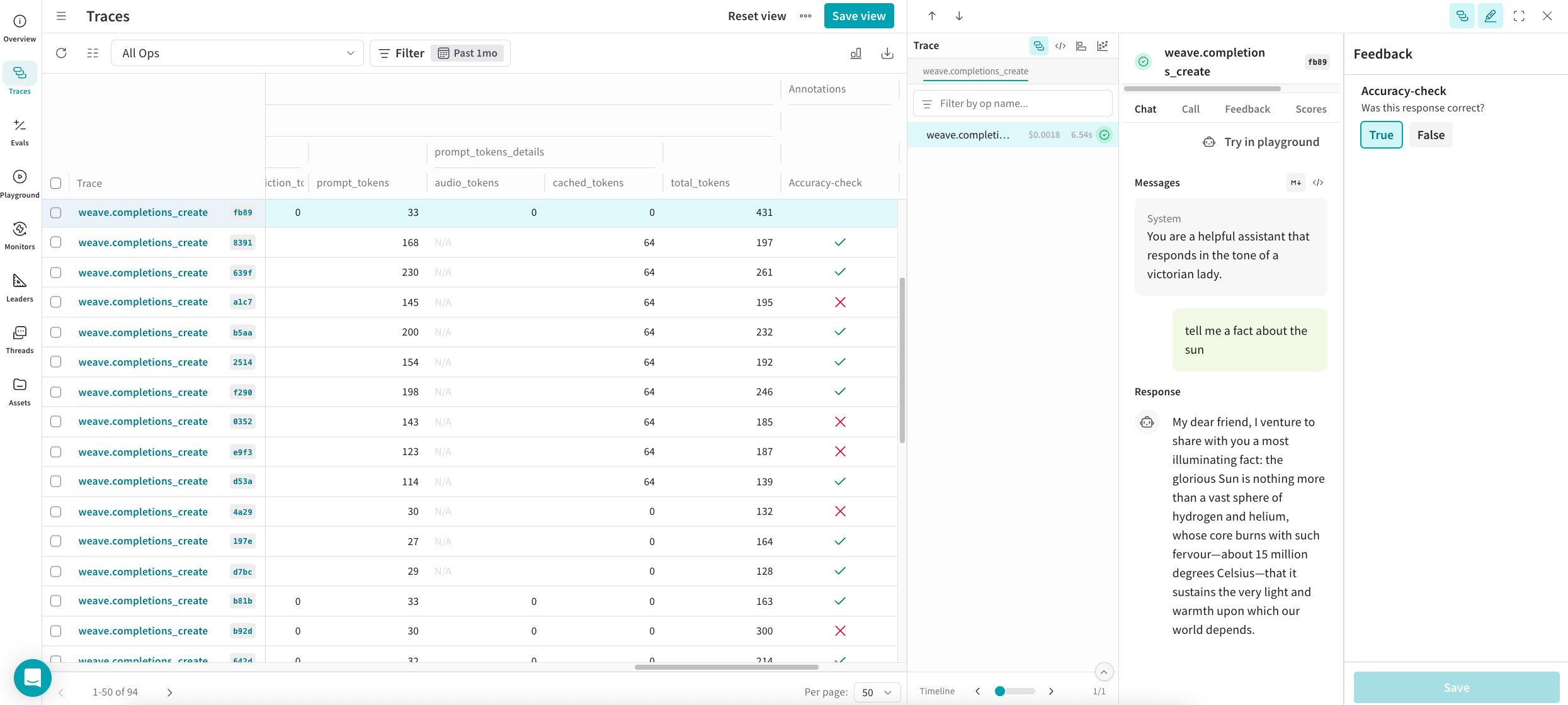
-
Make an annotation.
-
Click Save.
-
In the call details page, click Feedback to view the calls table. The new annotation displays in the table. You can also view the annotations in the Annotations column in the call table in Traces.
Refresh the call table to view the most up-to-date information.
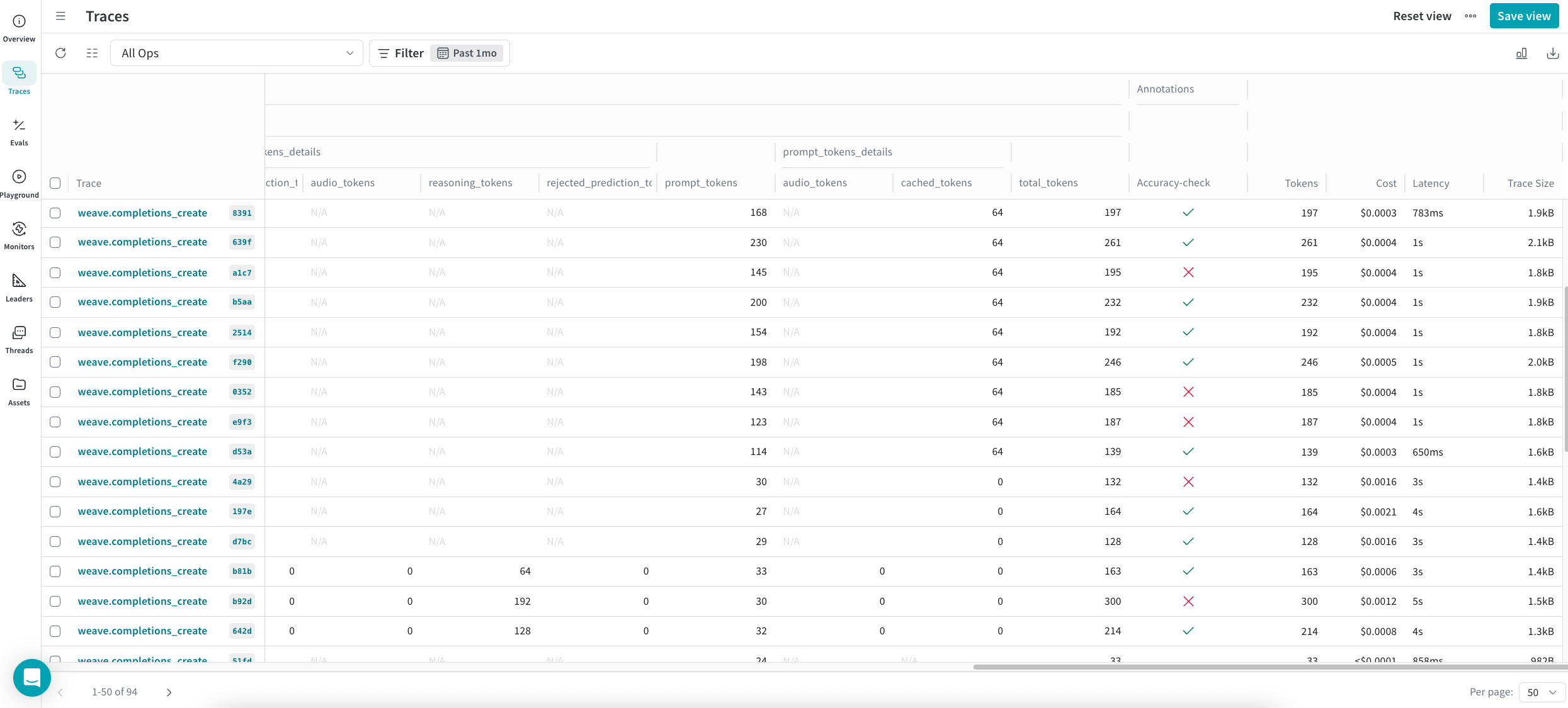
Create a human annotation scorer using the API
Human annotation scorers can also be created through the API. Each scorer is its own object, which is created and updated independently. To create a human annotation scorer programmatically, do the following:
- Import the
AnnotationSpecclass fromweave.flow.annotation_spec - Use the
publishmethod fromweaveto create the scorer.
In the following example, two scorers are created. The first scorer, Temperature, is used to score the perceived temperature of the LLM call. The second scorer, Tone, is used to score the tone of the LLM response. Each scorer is created using save with an associated object ID (temperature-scorer and tone-scorer).
- Python
- TypeScript
import weave
from weave.flow.annotation_spec import AnnotationSpec
client = weave.init("feedback-example")
spec1 = AnnotationSpec(
name="Temperature",
description="The perceived temperature of the llm call",
field_schema={
"type": "number",
"minimum": -1,
"maximum": 1,
}
)
spec2 = AnnotationSpec(
name="Tone",
description="The tone of the llm response",
field_schema={
"type": "string",
"enum": ["Aggressive", "Neutral", "Polite", "N/A"],
},
)
weave.publish(spec1, "temperature-scorer")
weave.publish(spec2, "tone-scorer")
This feature is not available in TypeScript yet. Stay tuned!
Modify a human annotation scorer using the API
Expanding on creating a human annotation scorer using the API, the following example creates an updated version of the Temperature scorer, by using the original object ID (temperature-scorer) on publish. The result is an updated object, with a history of all versions.
To view previous versions of scorers in the UI:
- From the sidebar, click Assets and then click Scorers from the list of assets to open a list of scorers in your project.
- The Versions column displays the number of available versions of for each scorer in your project. Click the (x) versions link to open a list of versions for the selected scorer.
- Python
- TypeScript
import weave
from weave.flow.annotation_spec import AnnotationSpec
client = weave.init("feedback-example")
# create a new version of the scorer
spec1 = AnnotationSpec(
name="Temperature",
description="The perceived temperature of the llm call",
field_schema={
"type": "integer", # <<- change type to integer
"minimum": -1,
"maximum": 1,
}
)
weave.publish(spec1, "temperature-scorer")
This feature is not available in TypeScript yet. Stay tuned!
Use a human annotation scorer using the API
The feedback API allows you to use a human annotation scorer by specifying a specially constructed name and an annotation_ref field. You can obtain the annotation_spec_ref from the UI by selecting the appropriate tab, or during the creation of the AnnotationSpec.
- Python
import weave
client = weave.init("feedback-example")
call = client.get_call("<call_id>")
annotation_spec = weave.ref("<annotation_spec_ref_uri>")
call.feedback.add(
feedback_type="wandb.annotation." + annotation_spec.name,
payload={"value": 1},
annotation_ref=annotation_spec.uri(),
)